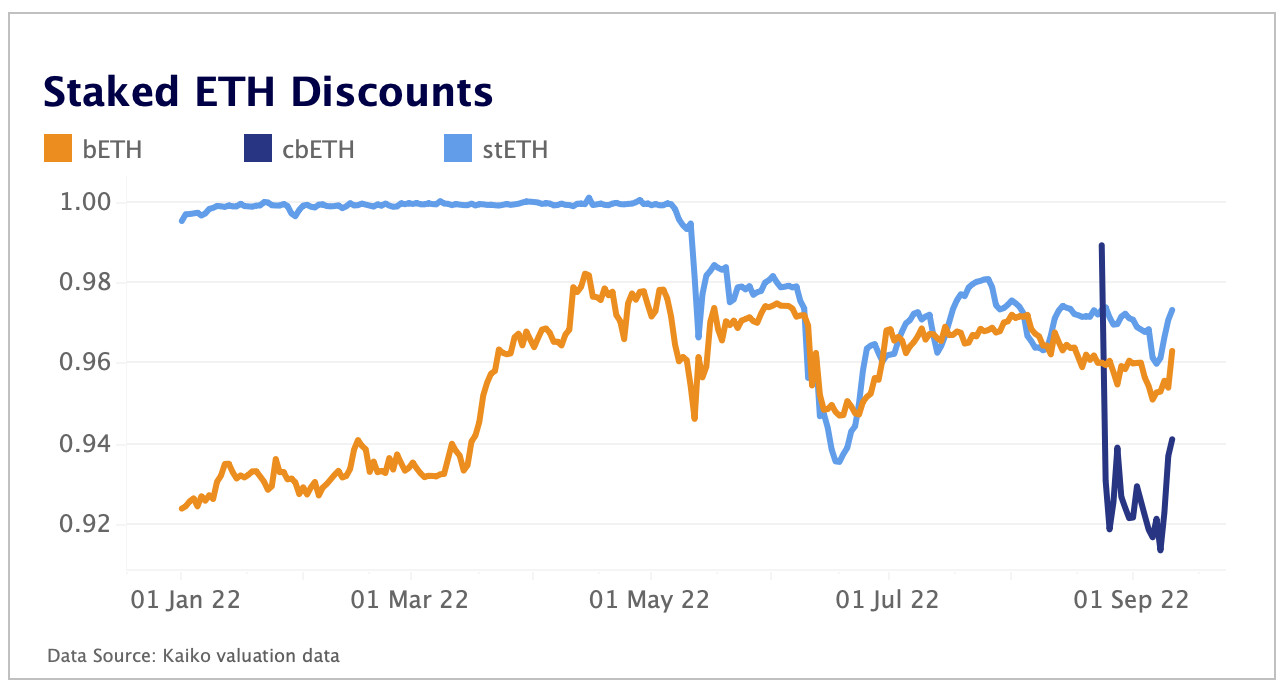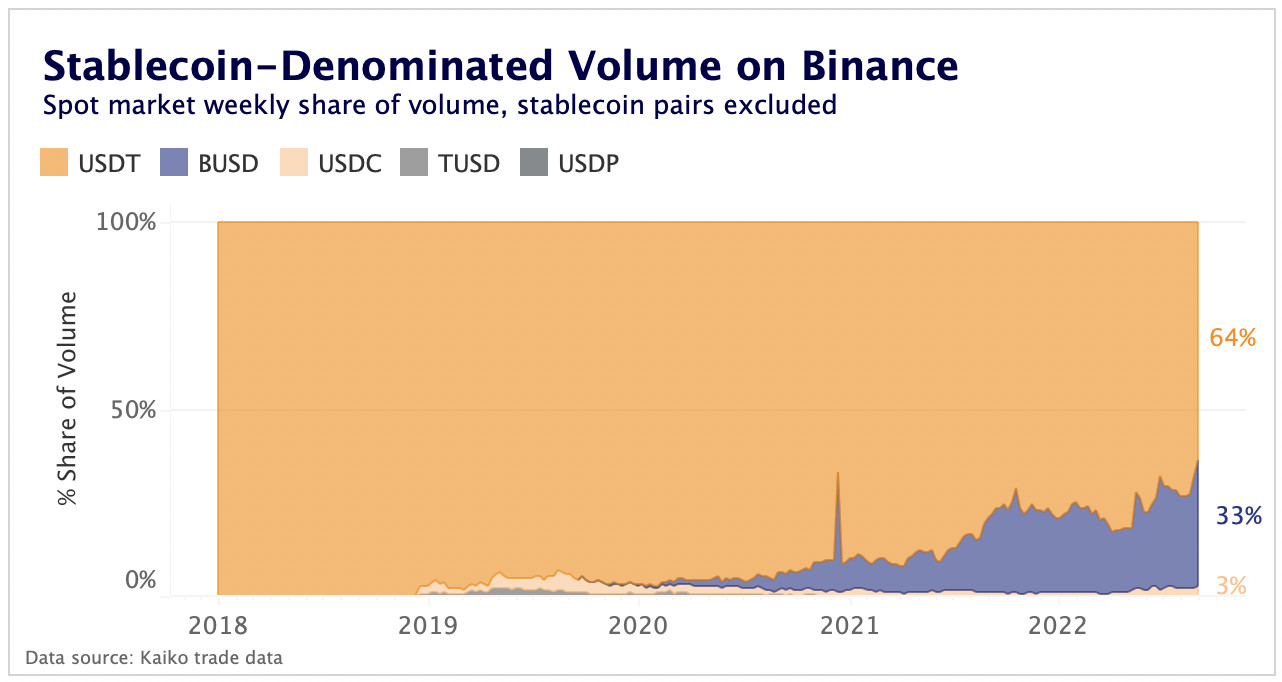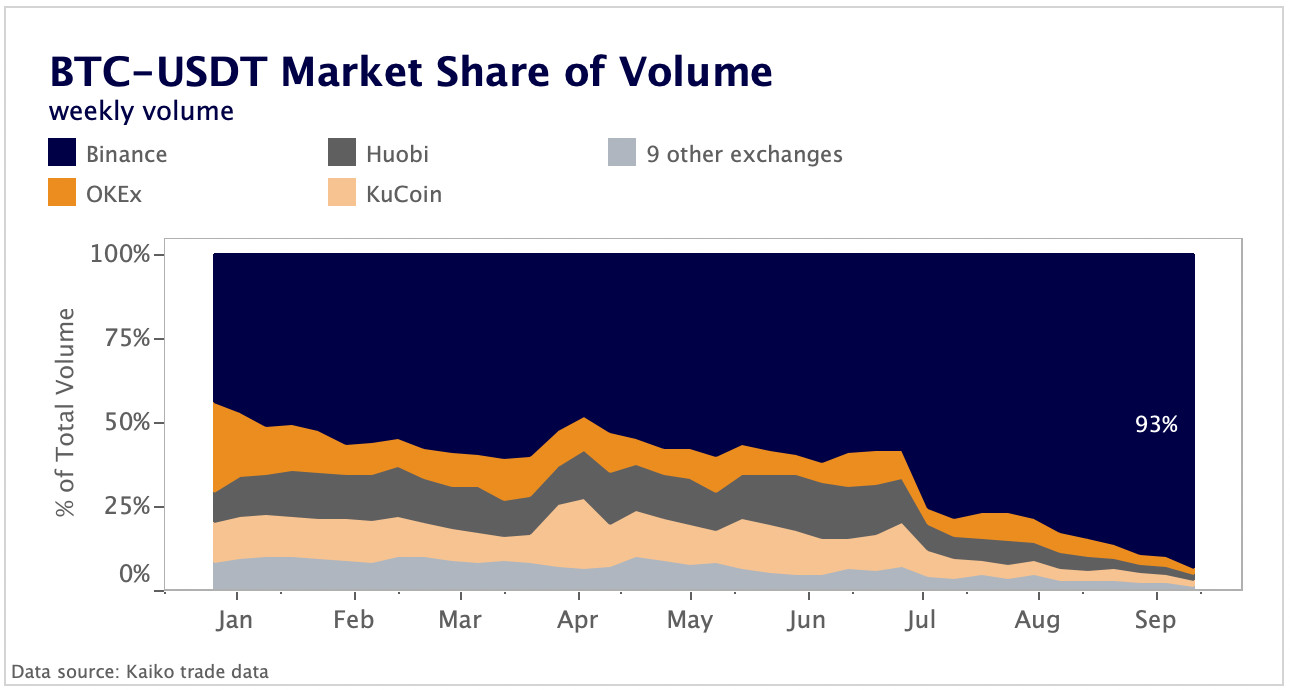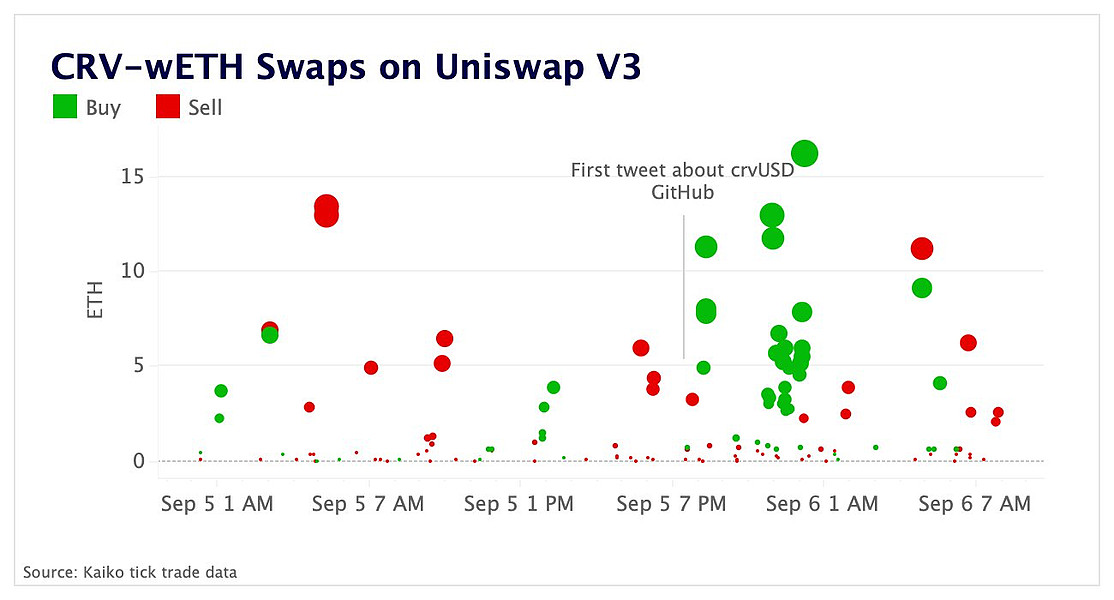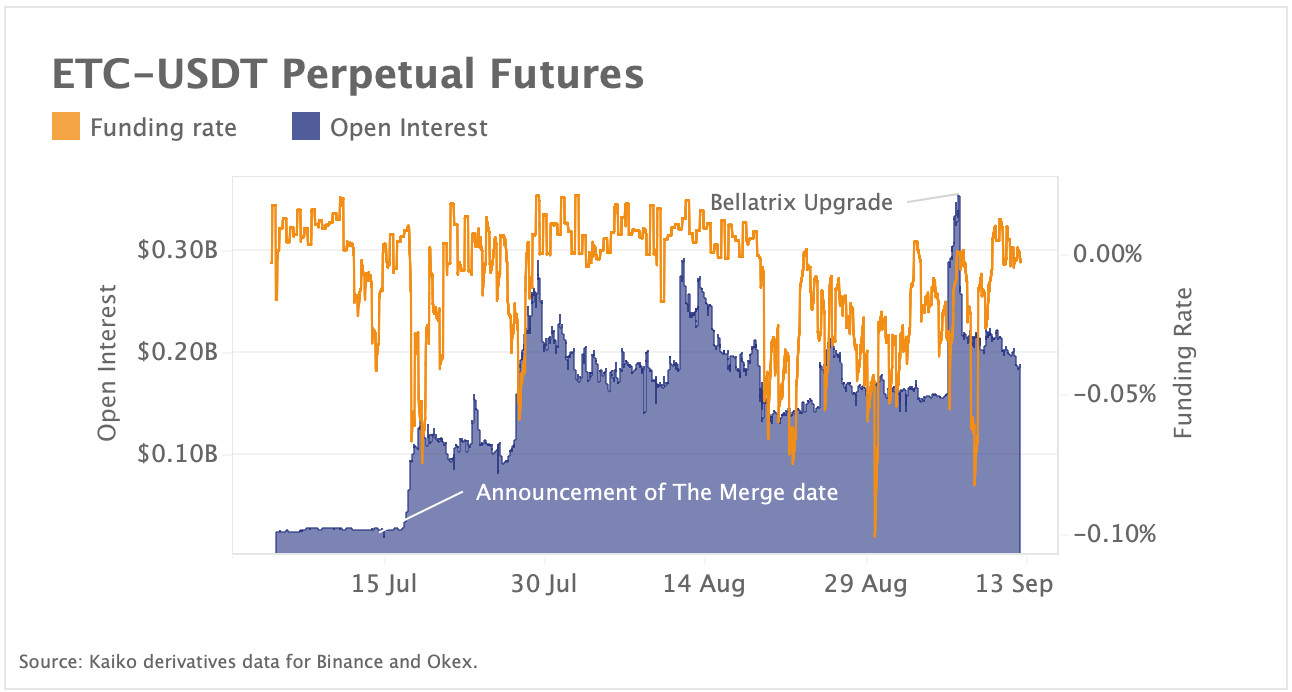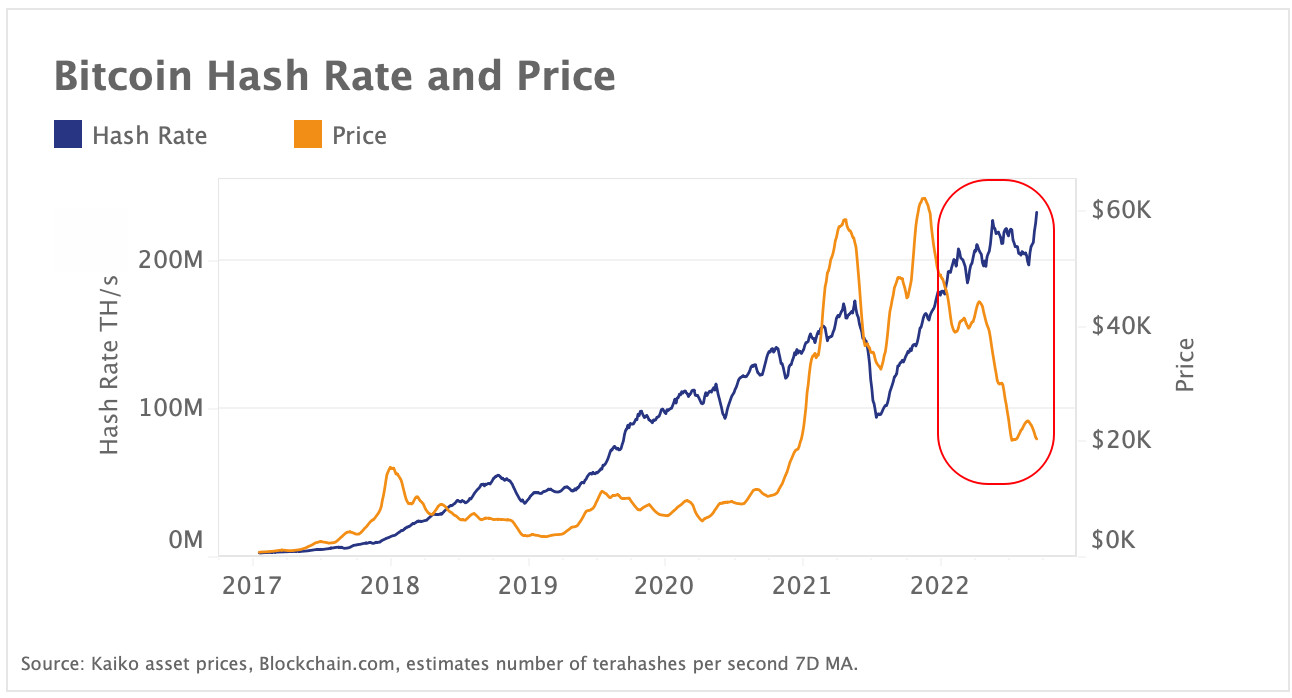A summarizing review of what has been happening at the crypto markets of the past week. A look at trending sectors, liquidity, volatility, spreads and more. The weekly report in cooperation with market data provider Kaiko.
The last 7 days in cryptocurrency markets:
- Price Movements: Markets experienced a strong rebound dominated by ETH, which closed the week up 12%.
- Market Liquidity: USDC, TUSD, and USDP accounted for just 3% of total stablecoin volume on Binance before the exchange announced plans to de-list pairs and auto-convert deposits to BUSD.
- Derivatives: Open interest for Ethereum Classic (ETC) recently hit all time highs as miners shift computational resources to the hard-forked PoW Ethereum chain.
- Macro Trends: Risk assets rallied despite the largest-ever ECB rate hike and growing energy concerns.
ETH dominates market recovery as Merge approaches
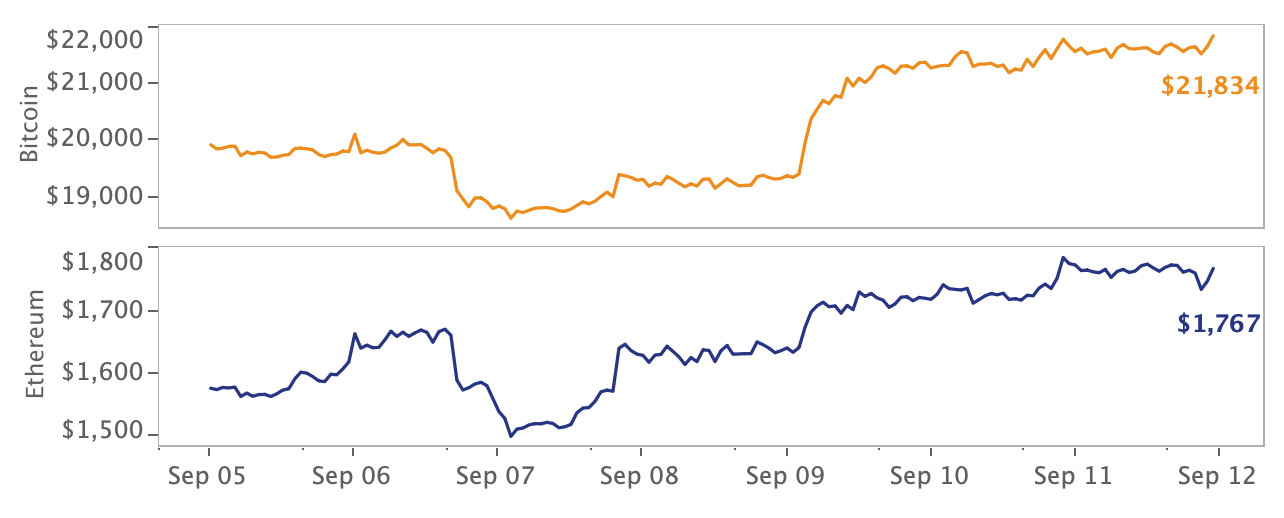
This week, the Kaiko Research team will be closely analyzing the effects that the upcoming Merge has on Ethereum (ETH) markets (and beyond). ETH closed the week up more than 12% with wider crypto markets experiencing a similar pump, pushing volatility to yearly highs. Derivatives markets are playing a particularly important role, with funding rates dipping sharply negative for ETH and open interest for ETC surging as miners prepare for the transition to proof-of-stake. In broader industry news, Coinbase proposed to acquire $1.6B of MakerDAO's USDC holdings, lending protocol Aave paused ETH loans, and the DEX Curve is one step closer to launching a stablecoin.
Staked ETH discount recovers slightly
Checking in on the state of staked Ether tokens ahead of the Merge, we can still observe a significant discount across the three largest staked ether tokens: stETH from Lido, cbETH from Coinbase and bETH from Binance. All three do not need to maintain a 1:1 peg to ETH as each token is redeemable sometime post Merge for 1:1 - the discount simply reflects the various risks perceived by investors in the meantime. cbETH is the most heavily discounted likely due to the added centralisation risk inherent with Coinbase’s regulatory positioning, however that discount improved significantly yesterday rising from 0.915 to just above 0.94. We also observed an improvement in the discounts for stETH and bETH as investors might be sufficiently happy with the discount to invest in both tokens, earning both the yield from the staked ETH as well as the price discount once the token is redeemable 1:1.
Binance to auto-convert stablecoin deposits to BUSD
Last week, Binance made waves with the announcement that all USDC, USDP, and TUSD stablecoin pairs would be de-listed and future deposits auto-converted to BUSD, the exchange's native stablecoin. Tether (USDT) markets will not be affected. Immediately following the announcement, there was strong pushback with claims that Binance was engaging in anti-competitive behavior by de-listing competitor stablecoins and that growing usage of BUSD would further consolidate the exchange's dominance. Yet, this move is more nuanced than what it appears, and could actually improve liquidity and price discovery on the exchange.
For years, USDC, TUSD, and USDP denominated trade volumes on Binance have hovered below 3%, accounting for a minuscule share of total market activity. Only USDC has observed any increase in volume over the years, growing from about $25mn in daily volume in 2020 to more than $200mn by 2022, although this still accounts for just a fraction of total stablecoin volume.
USDT could benefit from the elimination of stablecoin pairs on Binance
The stablecoin with the most to lose appears to be USDC, which has pretty good liquidity and decent volumes (by any other exchange's standards). Yet, the decision to de-list could actually be a good thing, explained by the CEO of Circle (USDC's issuer) in a concise twitter thread. Binance is simply consolidating dollar liquidity by reducing the number of dollar-equivalent pairs. USDC deposits will remain intact and the entire deposit experience will actually become smoother and more closely match what FTX already does today.
The question becomes whether the same fate could befall Tether markets. Currently, Binance's BTC-USDT pair is the most liquid trading pair in crypto. Since eliminating BTC trading fees, the pair now accounts for 93% of Tether market activity.Eliminating Tether pairs would have thus been quite the shock to cryptocurrency markets. Tether also remains mired in questions around its dollar liquidity, which auto-conversion into BUSD could have exacerbated.
GitHub for Curve's stablecoin goes live
The GitHub for Curve’s upcoming stablecoin, crvUSD, went live last week, prompting a string of buys for the DEX’s token CRV on Uniswap V3. The news began circulating just after 7pm UTC on September 5, after which a number of large buys were recorded, including a swap of 16 ETH for CRV; in total there was 170 ETH worth of CRV buys in the 5 hours following, while there were only 10 ETH worth of sells in that time frame. The GitHub does not contain any smart contracts, but provides some hints on the mechanics of the stablecoin, which is expected to be released after the Merge. It includes frequent references to LLAMMA, which stands for Lending-Liquidating AMM Algorithm. There have been a number of good analyses on how the stablecoin may operate, but much of this is speculation at this point. The release of crvUSD will mark a major shift in the DeFi stablecoin landscape, as Curve is still the most important stablecoin AMM.
Ethereum Classic gains traction in run-up to the Merge
The long-anticipated switch to proof-of-stake of the Ethereum network will replace energy-intensive mining with users staking ETH (validators), who will be responsible for adding new blocks to the chain. This has pushed Ethereum miners to look for alternatives with Ethereum Classic (ETC) – a proof-of-work fork of Ethereum that emerged in 2016 – gaining significant traction since July. Derivative markets reflect this shift in mining resources as traders look for a way to arbitrage and hedge the biggest upgrade of the Ethereum network in years.
ETC-USDT perpetual futures open interest aggregated on Binance and OKX spiked to an all-time high of 350mn on Sept 6, just after the launch of the Bellatrix upgrade, and has surged more than six-fold since July. Funding rates on ETC turned positive, suggesting stronger demand for leveraged longs positions and remained positive to neutral throughout last week. By contrast, ETH’s funding rates are well into negative territory, suggesting a combination of bearishness and heavy hedging.
Overall, strong capital inflows into ETC perpetual futures contracts coupled with its hash rate recently hitting an all-time high, is a clear sign that ETH PoW miners’ computational power has been transferred to ETC. The trend will likely continue as last week the second largest Ethereum mining pool, F2Pool announced it will halt ETH mining in September and transition to Ethereum Classic (ETC) instead.
Risk assets rally despite ECB hike and high gas prices
Risk assets rallied in sync last week despite the European Central Bank (ECB) delivering its largest-ever rate increase and signalling more to come. The aggressive move comes amid mounting recession fears in Europe after Russia cut natural gas supplies via the North Stream pipeline earlier this month. Despite gas prices easing from all-time highs after EU governments agreed on a coordinated market intervention to tackle the energy crisis, Europe’s benchmark gas price (Dutch TTF Futures) has more than doubled YTD. Europe has been hit harder by surging energy costs than the U.S., where the Fed is still hoping to avoid an outright recession, and is instead aiming for a period of low growth and high unemployment, i.e. a “growth recession”.
Bitcoin’s hash rate hits all time highs
Bitcoin’s hash rate just hit all time highs, completing an 18% increase since the end of August to 232mn TH/s (terahashes per second). The network’s hash rate – a gauge of the amount of computing power (i.e. miners) competing for blocks – declined over the summer as large US miners curtailed their operations in response to a historic heat wave in Texas, falling BTC prices, and rising energy costs. The summer is now over and energy costs are down, and high has rates suggests miners have re-entered the space in full force.
Well-capitalized miners weathered the downturn better than others and we observed some industry consolidation over the past few months. In addition to benefiting from power purchase agreements, large miners such as Riot registered profits following the Texas shutdown as they managed to sell electricity purchased previously back to the grid at a premium. BTC prices remain depressed from all time highs, though, which has negatively impacted miner profits.


